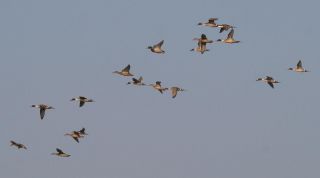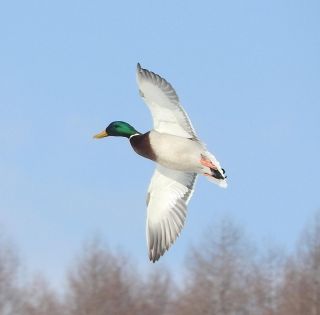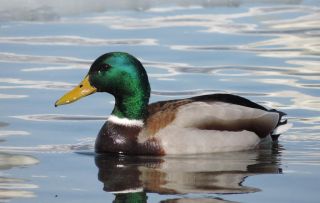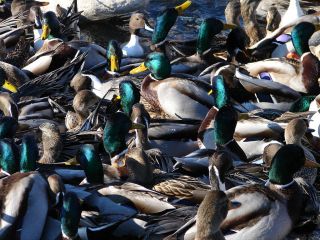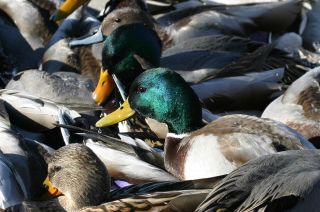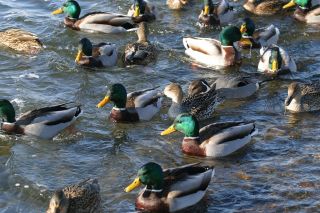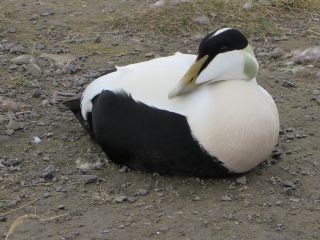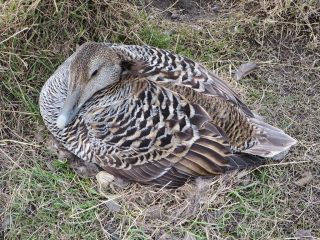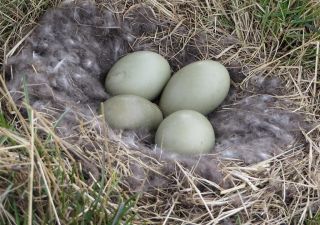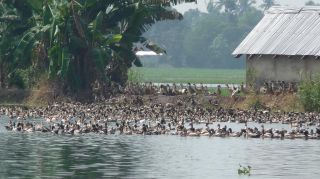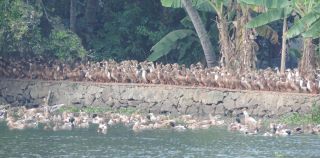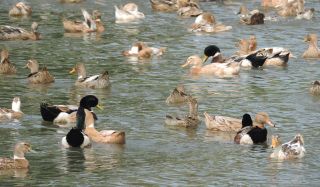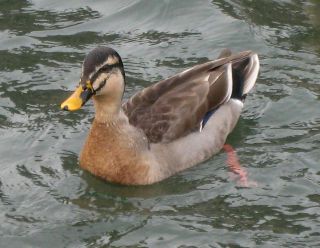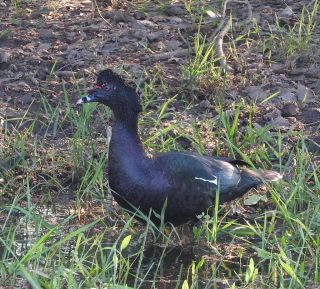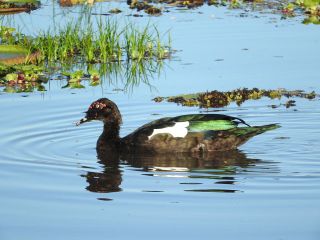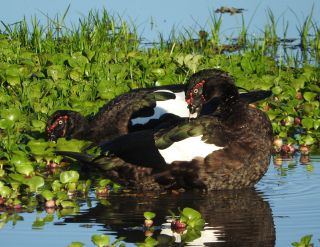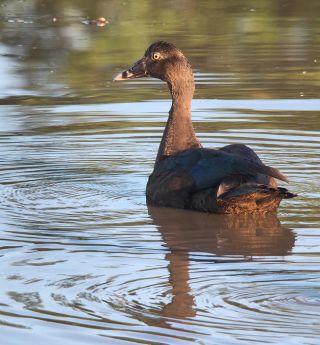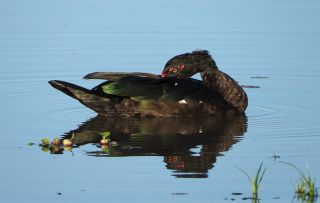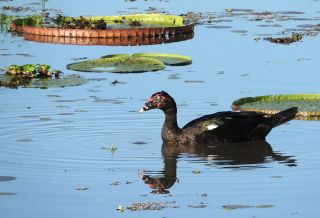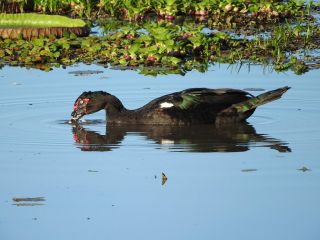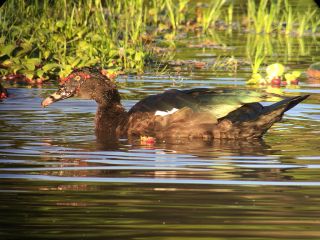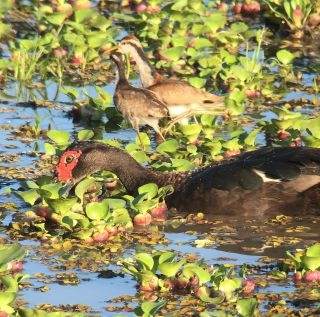A flock of Northern Pintail arriving into Japan for the winter © Mark Brazil
Duck Anyone? Mallard or Muscovite?
By Mark Brazil | Oct 31, 2016
Winter is arriving in Japan and with it come enormous numbers of water birds. They have spent the summer raising their young at taiga and tundra pools across a broad swathe of northeastern Asia and now swans, geese and ducks and their families are seeking refuge from the chilling effects of an approaching northern winter.
It is not that they are averse to the cold per se (after all they are dressed in one of the most insulating materials available – feathers and down) just that severe winter weather locks away their aquatic food supplies beneath frost, ice and snow. Here in Japan waterfowl can weather the winter and find food aplenty. From northern Hokkaido to southern Kyushu bays, estuaries, rivers, swamps, ponds, reservoirs and lakes fill increasingly with a wide range of species from the locally abundant Whooper Swan and Bewick’s Swan and Greater White-fronted Goose to the gaudy but shy Mandarin Duck. Huge numbers of Eurasian Wigeon, Northern Pintail and Mallard overwhelm the smaller numbers of Eastern Spot-billed Duck that are resident here in Japan to form spectacular wintering concentrations. Pay a visit to almost any popular riverside spot at this time of year and you will find a clamouring horde of semi-habituated waterfowl hoping for handouts from their human visitors. Meanwhile, around our coasts duck accustomed to salt water, such as Black Scoter, Long-tailed Duck and Harlequin are also building up in numbers.
The proximity between people and animals has led to a rather odd arrangement. In most cases, species interact as predators and prey, parasite or host, or they judiciously avoid each other, but in some cases other relationships prevail. We humans have an odd bond with the world around us; we are fully dependent on it, yet we live in denial of that fact, with a deep-seated desire to be completely independent, though that is clearly impossible. Doesn’t that sound like a strikingly familiar parallel relationship between parents and their children?
We humans also interact with many species in a predator-prey relationship, though almost invariably we are the predator. We hunt innumerable species for the bush meat trades to supply food in South America, Africa and Asia, while in the northern hemisphere hunting serves mainly as “sport” and “entertainment.” We have an additional relationship with other species though that is rare elsewhere in the natural world – involving husbandry and domestication.
Given the millions of wild species with which we share the planet and given how much of our food is derived from animals, it seems surprising just how few species of mammals, reptiles, birds and fish that we have domesticated during our history. We have done little more with plants and rely on an astonishingly narrow species base for the bulk of our plant food. Just think for a moment how few species of animals we have actually taken in and domesticated for regular use, whether for food, hunting, companionship, for wool, or as pack animals.
Perhaps the first to spring to mind is the dog, and it seems most likely that it was also the first species to have been domesticated. This strange association with animals seems so familiar to us today yet seems only to have begun a few thousand years ago, soon after our shift towards the seasonal farming that supported our permanent settlements. It seems that domestication began with the dog some 15,000 years ago or so. Other incidences of domestication followed. Often domestication took place in different parts of the world, but the process has been very slow, and a quick search reveals that we rely on fewer than fifty species of domestic animals.
Over the following 10,000 years or so after domesticating the dog as a hunting companion, we incorporated into our life styles, roughly in chronological order, the sheep, the pig, the goat, cattle and zebu, the cat, chicken, guinea pig, donkey, duck, the water buffalo, honey bee, horse, dromedary camel, silk moth, pigeon, goose, yak, Bactrian camel, llama, alpaca, guineafowl, ferret, mouse, ring-necked dove, muscovy duck, Bali cattle, and gayal. That small caste of creatures seemed sufficient to feed and support us during our first great population explosion.
More recently our pace of domestication has slowed almost to a crawl despite our ever-expanding population. The last two millennia have seen barely a dozen new domestications: the turkey, goldfish, rabbit, canary, Siamese fighting fish, rat, koi, silver fox, hedgehog, society finch and guppy. Most of these have been domesticated as pets or luxury items, not as food, though the turkey and rabbit are notable exceptions. I wonder how long it will be before we have our first truly domesticated insect food supply.
In addition to these few domesticated species, we have perhaps another hundred semi-domesticated species ranging from capybara, caiman, reindeer and ostrich, to salmon, mink, mealworms and medicinal leeches, all of which we breed for food, fur, feathers, leather, or other purposes, but aren’t truly domesticated. Full domestication doesn’t involve merely taming an animal so that it can be confined, but involves tinkering with its genetic constitution by selective breeding generation after generation. Eventually the domestic form undergoes significant modification of its genetic make-up and its behaviour, and exhibits morphological differences from the wild ancestors from which it was derived.
Despite there being approximately 140 species of duck in the world, the entire duck farming industry today is derived from just two wild species, the Mallard Anas platyrhynchos of the northern hemisphere and the Muscovy Duck Cairina moschata of South America. It seems that the first Mallard were domesticated c 6,000 years ago, whereas the Muscovy was a much later addition to our farming entourage, dating back only one two thousand years or so.
The vast majority of domestic duck breeds are derived from ancestral Mallard, and range in size from bantam to heavy weight, having been bred for a wide range of purposes not limited to eggs, down and meat. Many are kept as pets, or for their ornamental value. The various breeds derived from the Mallard have a strange range of names, frequently derived from a location, or from plumage colour, pattern or feature, such as: Australian Spotted, Call, East Indie, Bali, Indian Runner, Khaki Campbell, Magpie, Welsh Harlequin, Ancona, Buff Orpington, Blue Swedish, Cayuga, Crested, Appleyard, Aylesbury, Gressingham, Pekin, Rouen and Saxony.
In Europe and North America where chicken is the preferred meat (it is after all white and lean, and the birds themselves are so easily confined), duck is relatively scarce and hence more expensive, but in Asia the reverse is true in some countries. Ducks have been farmed for thousands of years, and the practice seems likely to have begun in Southeast Asia. Today, large flocks of domestic ducks roaming rice fields and riverbanks are a common sight in many parts of the region. While some are visibly very similar to wild Mallard, others look entirely different with pure white plumage and bright yellow bills and legs; nevertheless they are derived from the same wild stock.
The Mallard is in many ways the ideal species to be domesticated. It has such a malleable genetic code that it has tremendous interbreeding capability. Wild Mallard are not only fully interfertile with their domesticated “descendants,” but also capable of interbreeding with numerous other wild species to produce viable hybrids. This malleability makes them ideal stock for breeders.
Wild Mallard are also colourful, gregarious and capable of thriving in suburban and urban environments alongside people. This flexibility makes them attractive at the local duck pond, but a crisis in areas where they are not native. Their capacity to interbreed with local populations of related species leads to genetic pollution, hybridisation and in some cases the loss of local species through genetic swamping, a process that seems to be on-going in Hawaii, North America, Mexico and New Zealand with local species there.
Although the Mallard has contributed to the bulk of the global domesticated duck breeds, the Muscovy is an interesting anomaly. While watching a flock of wild Muscovy Duck in the Pantanal region of Brazil recently, I was puzzling over the origin of this extraordinary name. Surely there could be no connection with Russia, especially given that it is a South American native species. By chance, one of my travel companions happened to be from Russia and he was sufficiently intrigued to investigate a little himself. What he came up with sufficed at first, but did not seem to be the whole story. Seemingly, and perhaps plausibly, certain Russian sources at least consider that the bird was imported from South America into Western Europe by way of Russia, picked up the name Muscovy as it transited Moscow.
The scientific generic name for the Muscovy Duck, Cairina, can be traced to Aldrovandi the Italian naturalist of the 1500s who dubbed it Cairina meaning the “musky one from Cairo” in the mistaken belief that it came from Egypt. The Muscovy was also introduced to Japan for food, where it is called (equally unfathomably) Nobariken; however, it is the English name that intrigues me most.
The 17th century English naturalist John Ray insisted that the name was not derived from Muscovia (Muscovy), but from the strong musk-like odour the bird exudes. The association with the bird’s smell was cemented in 1758 when Carl Linnaeus renamed the “duck with a naked and carunculated face” as Anas moschata, meaning literally musk duck.
Etymologically “Muscovy” clearly refers to the region of Moscow, and in the context of this duck the name seems to date back to between 1550 and 1600. This may have been, as my Russian colleague suggested, because of a link to the Russian city. A chartered company known as the Muscovy Company is said to have traded the ducks to Europe. It was common in earlier centuries for imported products to take on the name of the company trading in them, but the Muscovy Company seems only to have had tenuous links with the Americas, making that derivation rather unlikely. Perhaps the name was no more accurate for a South American bird than the term Turkey is for a North American bird. Or perhaps an original local language name was corrupted into something sounding more familiar.
Recent research by archaeologist Kris Hirst indicates that the Muscovy was first domesticated in southern Peru perhaps in the first century AD, appearing very soon afterwards in Ecuador, but taking another 500-1000 years to reach south to Bolivia and north into central America. However, the true pattern may be very different given the general lack of data available. What does seem clear is the arrival of the Spanish into South America led to the Muscovy Duck being carried back to Europe, along with maize and potatoes, then subsequently spread more widely outside Europe. In Asia it has been bred for its rich, flavourful meat and nearly a dozen breeds are now known.
As you visit and watch wintering waterfowl concentrations this winter, do look out for oddities among the common species; these may be rarer species, hybrids, or perhaps domesticated duck that have escaped captivity and joined their wild brethren. And if you happen to be tucking in to duck at your favourite restaurant, you can be sure that it is either Mallard or Muscovy.
Outro
If you have read this far, then you may enjoy my previous articles, including recent offerings such as: Damsels and Dragons: Aerial Dancers (September 2016); Halcyon Days (August 2016); Isolated in the Izu Islands (July 2016); Japan’s Ubiquitous Scavenger – The Black-eared Kite (June 2016); Oriental Stork Making a Comeback in Japan (May 2016); Daijugarami: Stepping Stone to the Arctic (April 2016); Whale Watching Japan-style: Zamami (March 2016), Snow Monkeys & Cranes of Japan: Spectacular Winter Wildlife (February 2016), and Amami Night Safari (January 2016).
These Wild Watch articles, and many more, can be found on this website, and on our Facebook page (please do visit and hit the “Like” button).
Author, naturalist, lecturer and guide, Dr Mark Brazil has written his Wild Watch column continuously since April 1982, first in The Japan Times for 33 years, and since 2015 here on this website. All Wild Watch articles dating back to 1999 are archived here for your reading pleasure.
A collection of Mark’s essays The Nature of Japan and two handy pocket guides The Common and Iconic Birds of Japan and The Common and Iconic Mammals of Japan have been published and are also available from www.japannatureguides.com

